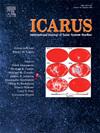源自月球的地球小卫星的稳定状态人口
IF 2.5
2区 物理与天体物理
Q2 ASTRONOMY & ASTROPHYSICS
引用次数: 0
摘要
这项工作考察了月球起源的合理性,这些自然物体的总能量相对于地球中心为负,即ET=势能+动能<;0,而它们在3个地球山半径(RH)之内,我们将其称为“束缚”。它们是非正式命名的“迷你卫星”的超级集合,迷你卫星要求物体在与地球一起旋转的联合框架内至少绕地球运行一次,并且它的地心距离在et0时的某个点为RH。有界天体也是地球共轨道天体的一个动态子集,它们与地球的平均运动共振为1:1,或者更具体地说,在类地轨道上。到目前为止,只发现了两个小卫星,2006 RH120和2020 CD3,而2024 PT5和2022 NX1符合我们的“束缚”条件。同轨道天体的可能来源区域要么是小行星的MB,要么是月球喷出物,要么是两者的结合。早期的研究发现,来自MB的小行星的动态演化可以解释观测到的小月球人口,但2020年CD3和2024年PT5以及地球共轨(469219)Kamo 'oalewa的光谱比任何MB小行星的光谱更符合月球玄武岩,这表明月球表面物质的喷射和随后的演化有助于小月球,更普遍地说,是地球共轨人口的形成。鉴于我们目前对月球撞击率、撞击者的能量、陨石坑尺度关系以及抛射物质量和速度之间的关系的理解,这项工作在数值上计算了束缚种群的稳态尺寸-频率分布。我们在数值上整合了月球抛射的轨迹,并计算了抛射后立即发生的“提示”弹射和物体在日心轨道上停留一段时间后发生的“延迟”弹射的统计数据。延迟界种群的一个子集构成了最小种群。我们发现月球喷出物可以解释观测到的被束缚物体的数量,但陨石坑形成和月球喷出物性质的不确定性导致预测的数量有许多数量级的范围。如果结合的物体可以根据其光谱区分为月球或小行星的起源,就有可能限制陨石坑形成过程以及物体从MB进入近地空间的动力学和物理演化。本文章由计算机程序翻译,如有差异,请以英文原文为准。
The steady state population of Earth’s minimoons of lunar provenance
This work examines the plausibility of a lunar origin of natural objects that have a negative total energy with respect to the geocenter, i.e. potential+ kinetic energy, while they are within 3 Earth Hill radii (), a population that we will refer to as ‘bound’. They are a super-set of the informally named population of ‘minimoons’ which require that the object make at least one orbit around Earth in a synodic frame rotating with Earth and that its geocentric distance be at some point while . Bounded objects are also a dynamical subset of the population of Earth’s co-orbital population, objects in a 1:1 mean motion resonance with Earth or, less specifically, on Earth-like orbits. Only two minimoons have been discovered to date, 2006 RH120 and 2020 CD, while 2024 PT and 2022 NX meet our condition for ’bound’. The likely source region of co-orbital objects is either the MB of asteroids, lunar ejecta, or a combination of both. Earlier works found that dynamical evolution of asteroids from the MB could explain the observed minimoon population, but spectra of 2020 CD and 2024 PT and Earth co-orbital (469219) Kamo‘oalewa are more consistent with lunar basalts than any MB asteroid spectra, suggesting that the ejection and subsequent evolution of material from the Moon’s surface contributes to the minimoon and, more generally, Earth’s co-orbital population. This work numerically calculates the steady-state size-frequency distribution of the bound population given our current understanding of the lunar impact rate, the energy of the impactors, crater-scaling relations, and the relationship between the ejecta mass and speed. We numerically integrate the trajectory of lunar ejecta and calculate the statistics of ‘prompt’ bounding that take place immediately after ejection, and ‘delayed’ bounding that occurs after the objects have spent time on heliocentric orbits. A sub-set of the delayed bound population composes the minimoon population. We find that lunar ejecta can account for the observed population of bound objects but uncertainties in the crater formation and lunar ejecta properties induce a many orders of magnitude range on the predicted population. If the bound objects can be distinguished as lunar or asteroidal in origin based on their spectra it may be possible to constrain crater formation processes and the dynamical and physical evolution of objects from the MB into near-Earth space.
求助全文
通过发布文献求助,成功后即可免费获取论文全文。
去求助
来源期刊

Icarus
地学天文-天文与天体物理
CiteScore
6.30
自引率
18.80%
发文量
356
审稿时长
2-4 weeks
期刊介绍:
Icarus is devoted to the publication of original contributions in the field of Solar System studies. Manuscripts reporting the results of new research - observational, experimental, or theoretical - concerning the astronomy, geology, meteorology, physics, chemistry, biology, and other scientific aspects of our Solar System or extrasolar systems are welcome. The journal generally does not publish papers devoted exclusively to the Sun, the Earth, celestial mechanics, meteoritics, or astrophysics. Icarus does not publish papers that provide "improved" versions of Bode''s law, or other numerical relations, without a sound physical basis. Icarus does not publish meeting announcements or general notices. Reviews, historical papers, and manuscripts describing spacecraft instrumentation may be considered, but only with prior approval of the editor. An entire issue of the journal is occasionally devoted to a single subject, usually arising from a conference on the same topic. The language of publication is English. American or British usage is accepted, but not a mixture of these.
 求助内容:
求助内容: 应助结果提醒方式:
应助结果提醒方式:


